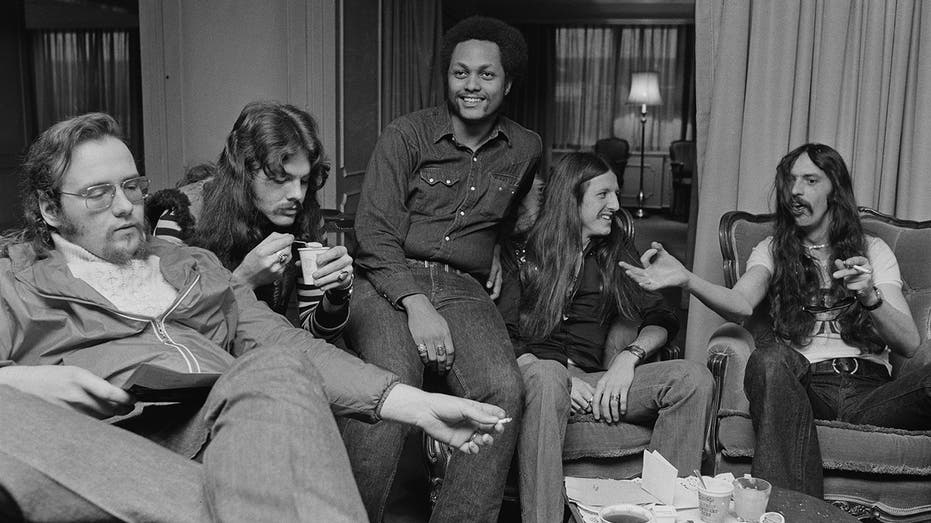Doobie Brothers founder on the band's Rock and Roll Hall of Fame induction, biggest hits
For Simmons, it’s all about the music and being able to bring to life the band's recordings
The Rock and Roll Hall of Fame: The pinnacle of an artist's career and for some, the final stop on their musical voyage that enshrines them among rock gods and goddesses.
For Patrick Simmons and the Doobie Brothers, who are part of this year's Rock Hall inductees alongside Whitney Houston, Nine Inch Nails, The Notorious B.I.G., T. Rex and Depeche Mode, joining the club of rock and roll royalty like Chuck Berry, Elvis Presley and Aretha Franklin is a special, humbling honor.
"I'm really thrilled part of it," Simmons told FOX Business. "I feel like it just makes it what we're doing much more meaningful in terms of our overall contribution. Hopefully, we've contributed something to the overall social world musically."
THE DOOBIE BROTHERS, WHITNEY HOUSTON, INDUCTED INTO ROCK AND ROLL HALL OF FAME
A San Jose, California, native, Simmons was the driving force behind some of the band's biggest hits, including their first No. 1 record, "Black Water," and has been with the band since its formation five decades ago, making him the longest-tenured member in the group's history.

American musician Patrick Simmons of rock group The Doobie Brothers, 1974. (Photo by Michael Putland/Getty Images)
Simmons' career with the Doobie Brothers started when he teamed with Tom Johnston, Dave Shogren and John Hartman to form the band in 1970. Known for his finger-picking guitar style of play, Simmons' early and eclectic record collection helped influence his creativity as a musician. From the harmonies of the Everly Brothers and Peter, Paul and Mary to smooth sounds of the "Kings of the Blues" (B.B. King, Albert King and Freddie King), these icons all played an integral role in the development of the Doobie Brothers' original folk-blues-rock sound.
The band's 1971 eponymous first album (and the single from it) failed to chart, which Simmons contributed to a sort of haphazard way the band was working on its songs, the quality of the studio and having two producers – one whom saw the band going with a folk-blues-type sound, the other with a vision more in-line with the group.
"We were just stumbling around in the dark trying to write songs that connect," Simmons said. "We kind of saw ourselves as a rock-blues-gospel-tinged band. And that's kind of where we ended up on that second album [“Toulouse Street”]. And I think that really enabled us to reach the audience that we were trying to reach."

American rock group The Doobie Brothers, London, January 1974. Left to right: John Hartman, Tom Johnston, Tiran Porter, Patrick Simmons and Keith Knudsen (1948 - 2005). (Photo by Michael Putland/Getty Images)
The Doobie Brothers made a splash on Billboard's Hot 100 chart with one of the singles from that second album called "Listen to the Music," now a staple to most classic rock playlists. The band's other hits came on their next few albums, including the chart-topping "Black Water," written by Simmons.
HERE'S WHY CONCERT PRICES REACHED RECORD-HIGH PRICES IN 2019
"You can't let … the Internet and the randomness of that convince you of what is good music"
In 1976, perhaps the most notable change the group went through was the addition of Michael McDonald, who replaced co-founder and frontman Johnston after his decision to step down from the band. McDonald was brought on to play keyboards and sing background, but eventually took over lead vocals, brandishing a soulful, R&B-style that transformed the band’s sound, something quite different from what their established fanbase was accustomed to.
"When we did that record 'Takin' it to the Streets' there was certainly a little nervousness about what kind of effect that was going to have on our audience," Simmons said. "But audiences are fickle … and luckily, we landed on our feet. We didn't have any idea that it was going to be as successful or as enjoyable as it turned out to be."
With McDonald, the band would see more hits, including the chart-topping "What a Fool Believes" from 1979 and other records making the top 20 on Billboard's Hot 100 chart.
Despite the changing times, where radio airplay has seemingly become less important than it was five decades ago at the band's inception, Simmons said the key to an artist connecting to a wider audience lies in the hands of technology – specifically, the Internet.
"People discover so much more because of the Internet and YouTube and you just stumble across things," he said. "The randomness of musical discovery is such that it can lead to thousands of fans overnight."
"[But] you can't let … the Internet and the randomness of that convince you of what is good music. You have to know that people need to have good ears and use them."
THE HIGHEST-GROSSING TOURING ARTISTS OF THE DECADE RAKED IN INSANE PROFITS
Still, recorded music generates just a fraction of an artist's income. Most of the earnings – about 90 percent – from a song go to the record company, Simmons said, with the remaining amount going to the artist. With that small portion, the artists pay for the production of the records (studio time, printing and packaging), all of which are recoupable, according to Simmons.
"That's the way it always been," he said. "So, by the time you see a royalty check, you've been paying for that record, every bit of it, all the way down the line."

Patrick Simmons, Tom Johnston and John McFee of The Doobie Brothers perform at 2016 Stagecoach California's Country Music Festival at Empire Polo Club on May 1, 2016, in Indio, California. (Photo by Frazer Harrison/Getty Images for Stagecoach)
Being an artist and having a good business sense isn't easy, the rocker said, noting many high-profile cases of stars declaring bankruptcy. Many times, he added, artists are taken advantage of or decide to sign away royalties from their songs early in their career in an attempt to make it mainstream and start playing live gigs.
GET FOX BUSINESS ON THE GO BY CLICKING HERE
Today, the band is preparing for its 50th-anniversary tour with McDonald that will kick off in June and have the band traveling across the U.S. and making stops in Canada. Today, live shows make up about 75 percent of a musician’s income, more than double what it was just two decades ago, according to a Wall Street Journal report. Demand, meanwhile, for these live events has also increased, in tandem with the cost of ticket prices for some groups.
CLICK HERE TO READ MORE ON FOX BUSINESS
But for Simmons, it’s all about the music and being able to bring to life the band's recordings.
"It is a unique experience, when you hear a song that's a popular song that you've heard hundreds of times and then you hear it live, it's like you're hearing it for the first time because it is different to hear the actual instruments directly relate to your ears. It's just a different experience."
